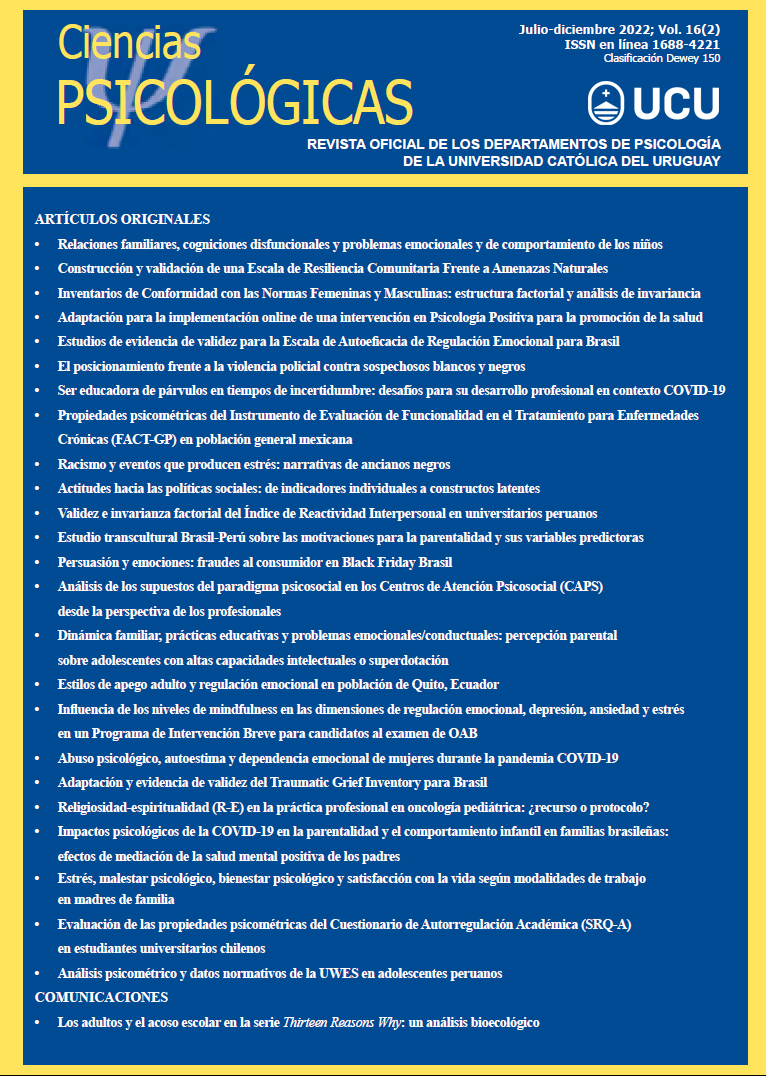Adults and school bullying in the series Thirteen Reasons Why: a bio-ecological analysis
DOI:
https://doi.org/10.22235/cp.v16i2.2713Keywords:
bullying, school violence, adolescents, audiovisual data, victimizationAbstract
School bullying is a serious public health problem and television drama series can contribute to shedding more light on its numerous facets. Hence, this study sought to analyze the discourses and practices of adults when they learn about or witness bullying situations in the television series Thirteen Reasons Why. This exploratory study employed a qualitative approach based on Bronfenbrenner’s Bioecological Theory. The methodological procedures comprised analyzing and selecting the episodes, identifying the scenes that contained bullying, classifying the adults’ perspectives and actions, and data analysis. We found an insufficient understanding of the adults in situations of bullying that were witnessed or known. Coercive behaviors, punishments, and transference of responsibility between contexts were the most identified actions. This study contributes to raising awareness among managers and civil society about the role of adults in managing and preventing cases of bullying in schools.
Downloads
References
Ahtola, A., Haataja, A., Kärnä, A., Poskiparta, E., & Salmivalli, C. (2012). For children only? Effects of the KiVa antibullying program on teachers. Teaching and Teacher Education, 28(6), 851-859. https://doi.org/10.1016/j.tate.2012.03.006
Analisah, C. D. C. & Indartono, S. (2019). Ecological Theory: preventing student bullying to promote culture of peace. Advances in Social Science, Education and Humanities Research, 323, 239-244. https://doi.org/10.2991/icossce-icsmc-18.2019.44
Braun, V. & Clarke, V. (2006). Using thematic analysis in psychology. Qualitative Research in Psychology, 3(2), 77-101. https://doi.org/10.1191/1478088706qp063oa
Costa, K. M. R. & Miranda, C. E. S. (2020). Associação entre bullying escolar e suicídio: uma revisão integrativa da literatura. Cadernos Brasileiros e Saúde Mental, 12(31), 312-327. https://doi.org/10.5007/cbsm.v12i31.69815
Fung, A. L. (2012). Intervention for aggressive victims of school bullying in Hong Kong: a longitudinal mixed-methods study. Scandinavian Journal of Psychology, 53(4), 360-367. https://doi.org/10.1111/j.1467-9450.2012.00953.x
Gaffney, H., Ttofi, M. M., & Farrington, D. P. (2021). What works in anti-bullying programs? Analysis of effective intervention components. Journal of school psychology, 85, 37-56. https://doi.org/10.1016/j.jsp.2020.12.002
Kollerová L., Soukup P., Strohmeier D., & Caravita S. C. S. (2021). Teachers’ active responses to bullying: Does the school collegial climate make a difference? European Journal of Developmental Psychology, 8(6), 912-927. https://doi.org/10.1080/17405629.2020.1865145
Levinzon, G. K. (2018). Thirteen reasons why: suicídio em adolescentes. Jornal de Psicanálise, 51(95), 297-306.
Moore, S. E., Norman, R. E., Suetani, S., Thomas, H. J., Sly, P. D., & Scott, J. G. (2017). Consequences of bullying victimization in childhood and adolescence: A systematic review and meta-analysis. World Journal of Psychiatry, 7(1), 60-76. https://doi.org/10.5498/wjp.v7.i1.60
Oliveira, W. A., Silva, J. L., Fernandez, J. E. R., Santos, M. A., Caravita, S. C. S., & Silva, M. A. I. (2020). Family interactions and the involvement of adolescents in bullying situations from a bioecological perspective. Estudos de Psicologia (Campinas), 37, e180094. https://doi.org/10.1590/1982-0275202037e180094
Olweus, D. (2013). School bullying: development and some important challenges. Annual Review of Clinical Psychology, 9(1), 751-780. https://doi.org/10.1146/annurev-clinpsy-050212-185516
Ribeiro, C. N. & Guerra, A. M. C. (2020). Adolescência, atos e o risco de suicídio. Psicologia USP, 31, e190108. https://doi.org/10.1590/0103-6564e190108
Rivara, F. & Le Menestrel, S. (Eds.). (2016). Preventing bullying through science, policy, and practice. National Academies Press.
Senna, S. R. C. M. & Dessen, M. A. (2012). Contribuições das teorias do desenvolvimento humano para a concepção contemporânea da adolescência. Psicologia: Teoria e Pesquisa, 28(1), 101-108. https://doi.org/10.1590/s0102-37722012000100013
Silva, J. L., Oliveira, W. A., Bazon, M. R., & Cecílio, S. (2014). Bullying: conhecimentos, atitudes e crenças de professores. Psico, 45(2), 147-156. https://doi.org/10.15448/1980-8623.2014.2.12683
Silva, N. D. & Rodrigues, R. F. L. (2020). The importance of the school psychologist: A look at the “13 reasons why” series. Research, Society and Development, 9(9), e409997361.
United Nations Educational, Scientific, and Cultural Organization. (2019). Violência escolar e bullying: Relatório sobre a situação mundial. Representação da UNESCO no Brasil.
Zequinão, M. A., Medeiros, P. de; Pereira, B., & Cardoso, F. L. (2016). Bullying escolar: Um fenômeno multifacetado. Educação e Pesquisa, 42(1), 181-198. https://doi.org/10.1590/s1517-9702201603138354
Zequinão, M. A., Medeiros, P., Silva, J. L., Pereira, B. O., & Cardoso, F. L. (2020). Sociometric status of participants involved in school bullying. Paidéia (Ribeirão Preto), 30, e3011. https://doi.org/10.1590/1982-4327e3011
Downloads
Published
How to Cite
Issue
Section
License
Copyright (c) 2022 Universidad Católica del Uruguay

This work is licensed under a Creative Commons Attribution 4.0 International License.
















